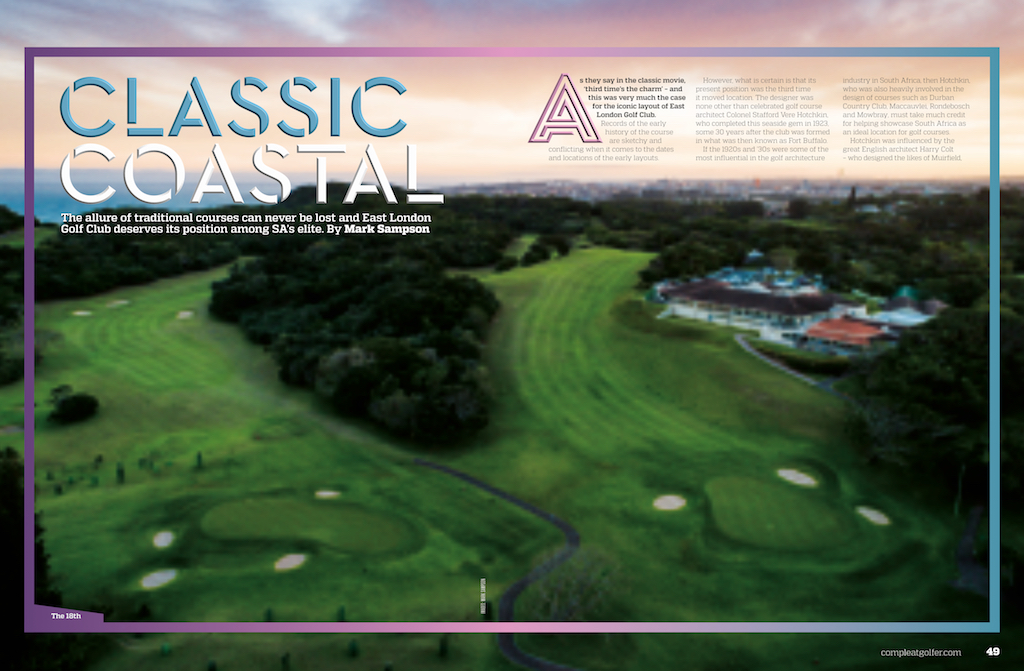As they say in the classic movie, ‘third time’s the charm’ – and this was very much the case for the iconic layout of East London Golf Club.
Records of the early history of the course are sketchy and conflicting when it comes to the dates and locations of the original layout.
However, what is certain is that its present position was the third time it moved location. The designer was none other than celebrated golf course architect Colonel Stafford Vere Hotchkin, who completed this seaside gem in 1923, some 30 years after the club was formed in what was then known as Fort Buffalo.
If the 1920s and ’30s were some of the most influential in the golf architecture industry in South Africa, then Hotchkin, who was also heavily involved in the design of courses such as Durban Country Club, Maccauvlei, Rondebosch and Mowbray, must take much credit for helping to showcase South Africa as an ideal location for golf courses.
Hotchkin was influenced by the great English architect Harry Colt – who designed the likes of Muirfield, Royal Liverpool and Royal Portrush – and his affinity for links-style layouts is evident in his involvement with courses such as Humewood, Royal Port Alfred and East London.
Using the natural lie of the land without making massive changes to nature’s design was at the heart of most of his creations. As such, East London’s course flawlessly follows a ‘natural’ routing towards the ocean and back through thick indigenous coastal bush. The front nine is very much the tighter of the two nines, as well as lying closer to the ocean.
The entire course is draped over undulating dunes and generally flows in a north-east to south-west direction, which results in most of the holes playing into the prevailing winds. Relatively large sloping greens can be expected as well as numerous changes in elevation.
At under 6 000m from the tips (and a par 73), it is certainly a short course by modern standards and, as such, is a shot-maker’s paradise, with club selection being the order of the day. The front nine has some narrow targets and dramatic changes in elevation. The par-three 2nd is one of the more well-known holes, with an elevated tee playing down to the well-protected green cut into the thick bush.
The tee tends to be protected from the wind, making club selection difficult. Anything long and a double could easily be on the cards, while the prevailing crosswind brings any of the five bunkers into play.
The par-four 5th hole epitomises the East London layout. At 254m, many golfers will feel they can overpower the hole with ease. However, the narrow fairway, that slopes aggressively upwards and then drops down dramatically to the hole, must be found. Anyone trying for too much off the tee might well end up losing a ball.
The back nine has more of a parkland feel and is a lot more forgiving, with wider fairways and a first cut of rough that helps buffer any wayward shots before they find the bush. In general, it also has fewer dramatic changes in elevation.
The par-four 12th and 18th holes are two holes you will remember long after your round is complete. The 12th is regarded as the signature hole (see page ?? ) while the 18th has caused many a tournament leader to fall back into the pack. At 350m, it is not massively long but the hole can be extremely intimidating, especially if it is played into the south-easter coming across the fairway.
The tee box is cut way back in the thick bush and the tee shot is blind. Anything from a 7-iron to a driver can be used to find the massively sloping fairway as it winds its way down past the clubhouse. Bending from right to left, a draw for the right hander would be ideal to leave a mid- to short-iron into a large green that is protected by two bunkers on the left and one on the right.
In all likelihood your approach will be off a downhill lie, which adds to the fear-factor of this hole.
The unique layout is amplified by the fact the course has only three par threes and plays to a par of 73, with the front nine being 37. It may be because one is ‘missing’ but the three short holes are unique and memorable. All three play from an elevated tee to a well-protected green and all play from a different direction. Between the wind and drops in altitude, they can be a very tricky trio indeed.
Classic courses very seldom need any major design changes over the years and this is very much the case, as it should be, at the East London club. Courses are all too often changed to suit members, and in doing so risk losing the authenticity of the architect’s original layout. At East London, the only major changes came in 2008 when the green complexes received some attention.
Golf course architect Mark Muller was charged with changing the putting surfaces from the original Cynodon grass species to the more favourable Paspalum and to make some adjustments to a number of bunkers. The authenticity of this legendary course, nestled on the dunes between the Nahoon and Buffalo Rivers, in the heart of East London, was very much kept intact.
The future of the course is also looking very bright with the arrival of golf director Andrico Steyn. Bringing vast experience from the United Kingdom, Lithuania and Russia and knowing the local market from time spent at Pinnacle Point, Steyn arrives with a pedigree and ambition worthy of the course.
He says his goal is to return the course to its glory days when it hosted major tournaments like the SA Open (it has hosted six), the African Open (a European Tour event) and make it a preferred destination for the numerous amateur tournaments such as the SA Country Districts tournament, which it hosted in May.
The corridors of the East London clubhouse come alive with names of South African golfing greats who have played, and won, here. The likes of Bobby Locke and Sid Brews, Gary Player and Mark McNulty, Retief Goosen and Ernie Els all spring to mind, with Ernie winning the SA Amateur Championship in 1986 on the layout.
When the Africa Open was hosted here, from 2009 to 2015, the list of champions, including Goosen, Louis Oosthuizen (twice), Charl Schwartzel, Darren Fichardt, Thomas Aiken and Trevor Fisher Jr, proved how great golf courses tend to produce great champions.
The clubhouse, perched high above the course, overlooks the 18th, 1st and 7th greens and is a warm, welcoming facility. It was recently upgraded in 2015 and has a number of facilities the local market can tap into as a safe, secure environment. From conferencing to weddings, a number of options are available for larger parties or the more discreet private occasion.
It also has a fully-stocked pro shop offering one of the few places in the region to buy golf equipment and apparel. Like so many Eastern Cape courses, the warmth of the 19th can be felt, and heard, from out on the course.
Regardless of how the 18th treats you, the excited laughs and joyful cacophony emerging from the bar area will lure you in and cure any heartache the course may have bestowed upon you.
As always, it’s very much the members that make a course and East London has a long list of lifetime members who do just that.
Authentic and heartfelt hospitality can be expected on arrival, from the gentlemen at the entrance all the way to the barman.







